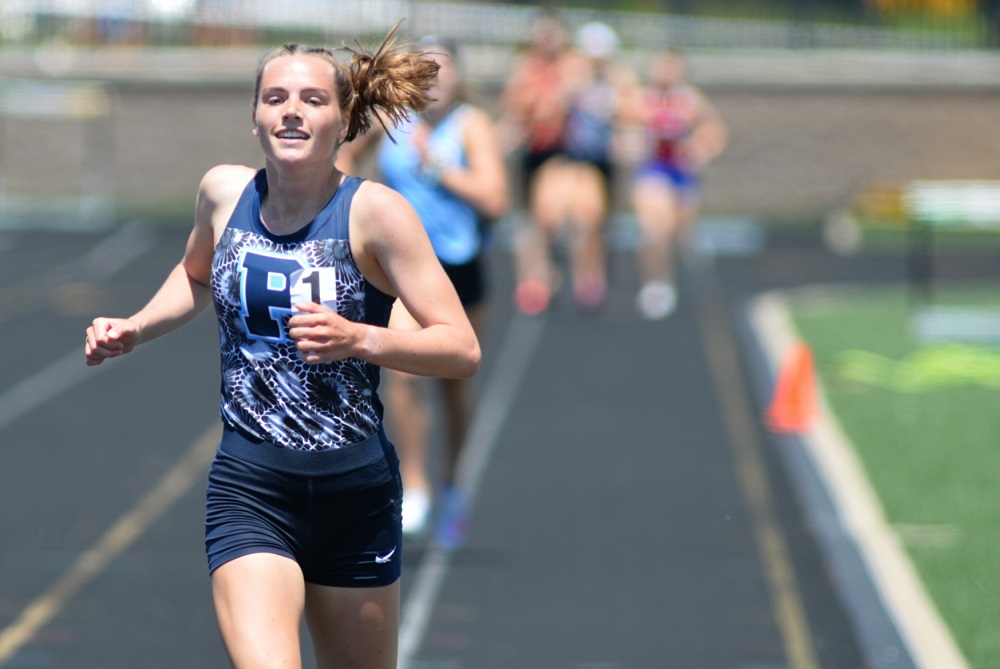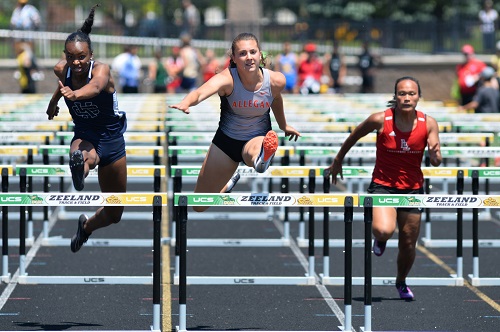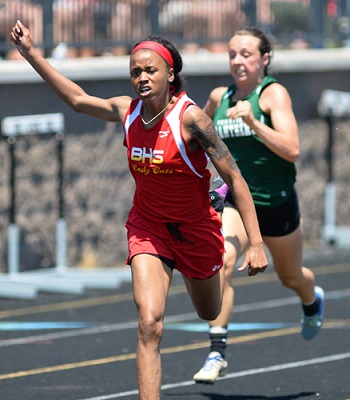
Petoskey Goes Distance Again for 1st Track Finals Win
June 6, 2021
ZEELAND – Petoskey went the distance again Saturday at the Lower Peninsula Division 2 Girls Track & Field Finals.
After claiming the Division 2 cross country championship in the fall, with senior Emma Squires the individual race winner, the Northmen were bolstered by Squires again in winning their first Finals title on the track.
Squires won the 800 (2:14) and 1,600 (4:55.05), finished second in the 3,200 and anchored the winning 3,200 relay (9:27.33) at Zeeland, which added up to 38 of Petoskey’s total 48 points. Parma Western was second with 29.
The Northmen’s only other top-two Finals finish had come in 1992, when they finished Class B runners-up.
“It definitely was a really hot, windy day, definitely not the best conditions, but we just had to gut through it,” Squires said. “It was definitely the hardest race and meet ever this season.
 “The past two weeks definitely we’ve all been stressing about it. But we tried to sleep well and eat well and train well, and it definitely worked out well. We all peaked at the right time.”
“The past two weeks definitely we’ve all been stressing about it. But we tried to sleep well and eat well and train well, and it definitely worked out well. We all peaked at the right time.”
Squires was joined the on the 3,200 relay by senior Sarah Liederbach and juniors Noel Vanderwall and Caroline Farley. Vanderwall also joined Squires finishing fourth in the 1,600 and sixth in the 3,200, and Farley was right there with a seventh in the 3,200 as well.
“The distance girls won the state championship in cross country, and that’s where all of our points came from today,” Petoskey coach Karen Starkey said. “Throughout the year they worked hard, and we had some not-so-good weather, but everybody just worked together and it was positive. … They have a lot of guts, desire, and they’re a good group of girls and we’re going to miss them.
“I was pretty confident they would perform (Saturday) as they did all season long. It’s unusual to have goose bumps on an 88-degree day. And that happened several times today.”
Bridgeport junior Chaniya Madison was among those who powered through as well, as she won the 100 (12.36) and 200 (25.96) to score 20 of third-place Bridgeport’s 26 points. She previously had won the 100 as a freshman in 2019. Allegan senior Hannah Antkoviak was another double champ, claiming the titles in the 100 hurdles (14.94) and 300 (44.69).
 Big Rapids’ senior Erika Beistle also gave a two-title good-bye to her high school career with a 20-foot win in the discus (147-5) while claiming the shot put championship (42-10) as well.
Big Rapids’ senior Erika Beistle also gave a two-title good-bye to her high school career with a 20-foot win in the discus (147-5) while claiming the shot put championship (42-10) as well.
Belding freshman Brook Simpson, meanwhile, debuted by setting the LPD2 meet record in the high jump at 5-10, besting the 5-9 jumps by Sara Jane Baker of Mattawan in 2001 and Christine Krellwitz of Big Rapids in 2004.
Bloomfield Hills Cranbrook Kingswood senior Kaya Freeman won the long jump (17-4), and Grand Rapids West Catholic senior Katie Clifford won the pole vault (12-0). Simpson also finished second in the 400 to Marysville junior Reese Powers, who crossed first in that race in 57.71 seconds. Linden won the 400 relay (50.36), Hudsonville Unity Christian won the 800 relay (1:47.14) and Dearborn Divine Child won the 1,600 relay (4:04.32).
PHOTOS: (Top) Petoskey’s Emma Squires outpaces the field during one of her championship runs Saturday at Zeeland. (Middle) Allegan’s Hannah Antkoviak, middle, works to stay just ahead of Cranbrook’s Kaya Freeman (left) and Stevensville Lakeshore’s Lynea Slayback. (Below) Bridgeport’s Chaniya Madison powers through the final strides of one of her sprint victories. (Photos by Dave McCauley/RunMichigan.com.)

Track Gaining Speed Toward Future with Electronic Starting Devices
By
Steve Vedder
Special for MHSAA.com
May 23, 2023
Aubrey Greenfield thinks it might be the perfect time to reevaluate 130 years of tradition.
For a number of reasons, from technical to personal, the Oxford senior sprinter believes it makes sense for the crack of a starting pistol to be eliminated from high school track meets.
Because track meets would benefit in various ways from lowering costs to easier setup at meets to the human factor of competitors not having to flinch at the crack of a pistol shot, Greenfield believes the sport has a chance to embrace new technology – electronic starting devices (ESD).
In essence, an ESD replaces the starting pistol with a light flash, tone sound or both to begin a race.
"High school sports should put the athlete first," Greenfield said. "We should promote sports, and eliminating starting pistols promotes health in terms of PTSD or trauma for athletes and spectators and that would be good. I would like to think people would say that's a good idea."
In fact, Greenfield would go as far as to say if there was not an implementation of electronic starting devices, many of her teammates would have considered giving up the sport.
"If it's something that helps us compete safely, we're all for it," she said.
Greenfield's opinion apparently is spreading. Michigan High School Athletic Association senior assistant director Cody Inglis said the use of ESD makes it both affordable for meet starters and sensible for athletes and fans to rethink the use of starting pistols. While the MHSAA is not mandating electronic starting devices, it does promote the use of what Inglis calls "emerging technology." He notes that ESD are becoming the norm for organizations such as USA Track & Field, the NCAA and an increasing number of high schools.
 "I think we have to embrace new technology, and we think this will be something that takes hold," Inglis said.
"I think we have to embrace new technology, and we think this will be something that takes hold," Inglis said.
A key part of embracing ESD is the human element. The tragic Oxford High School shooting Nov. 30, 2021, that took the lives of four students while injuring seven others should not be relived even for a fleeting instance at a high school sporting event. Oxford athletic director Tony DeMare said the school began using ESD at every meet, including the MHSAA Lower Peninsula Division 1 Finals last June. He said that decision was embraced by virtually all schools Oxford encountered.
"We were very convinced that the alternative (of ESD) would promote a healthy attitude," DeMare said. "We were overwhelmed with the positive response. If a school was on the fence about it or might not be for it, I think we've started to see the tide turn in favor of people willing to listen and learn about electronic starting devices."
Inglis said the MHSAA is acutely aware of what the crack of a starting pistol can mean to athletes and fans.
"It's unimaginable what Oxford went through, and this is a small way we can help," he said. "We look at a (starting pistol) and think, ‘Could we do something else?’ It's a way of helping to solve a problem."
Over the last several years, the MHSAA has embraced finding an alternative to starting pistols. Inglis noted the discussion started with the cost and diminishing availability of 32-caliber ammunition that meet starters use. A box of ammunition, if it can be found, is around $75 a box.
In addition to cost, there is potential damage from excessive exposure to 150-plus decibels of sound generated by the traditional 32-caliber blanks. Medical studies show damage to ears caused by decibel levels above 120 dB.
The tragedy at Oxford accelerated the conversation.
Inglis said the cost of ESD can be likened to a school sinking money into artificial surfaces at football fields. Yes, there is a great cost at first, but over time money is ultimately saved. An ESD system itself ranges between $200 and $500. Speakers also may need to be purchased, but with ESD starting events like the 800 and 1,600-meter relays positioned near the outside lanes 8, 7, 6 and 5 would result in improved hearing by athletes at the start of a race.
There is one challenge with ESD that track administrators are working to overcome – lighting conditions that lessen the ability to see the ESD’s LED light or strobe when the button is pressed by a starter to begin a race. But that vision difficulty resulting from clear blue skies and backgrounds of setting suns can be substantially improved by incorporating a black background with an ESD – something as simple as a starter holding up black cardboard behind the lighting mechanism at the start of an event.
Inglis said when all factors are considered, the use of ESD makes sense.
 "With the climate we live in nowadays, no lookalike guns is good," he said. "We're not mandating this. But people are saying this is affordable."
"With the climate we live in nowadays, no lookalike guns is good," he said. "We're not mandating this. But people are saying this is affordable."
While switching to ESD would break 130 years of tradition, the timing could be a step forward, said Jeff Hollobaugh, co-author of the book "The Fleet Feet of Spring: Michigan's High School State Championships in Track & Field." He said while no definitive answer is possible, it's likely starting pistols were used at the inaugural state meet at the Jackson Fairgounds in 1895. The meet, which included events like tossing a 16-pound shot put, bike races and a 100-meter sprint, was sponsored by the Michigan Interscholastic Athletic Association (a predecessor to the MHSAA) and comprised mostly of the state's larger schools.
Hollobaugh's sentiments echo what many involved in today's high school track & field believe in terms of making a transition from starting pistols to electronic starting devices.
"It's a change, not necessarily good or bad, just different," he said. "It's not a drastic change, but it will take some getting used to. But it is the future. In the end, we'll all be fine."
DeMare believes the future of high school track will definitely include ESD.
"Our desire is that the practicality and sensibility of this will overcome the alternative," he said. "I think we'll see the automation and electronics taking hold of certain elements in track, and people will embrace it."
PHOTOS (Top) Runners watch official Bertha Smiley as they prepare to begin a race during last season's Lower Peninsula Division 1 Finals at Rockford. (Middle) An electronic starting device provided by VS Athletics was used to start those races. (Below) Smiley sets to begin an event. (Photos provided by David Kuderka/VS Athletics.)

